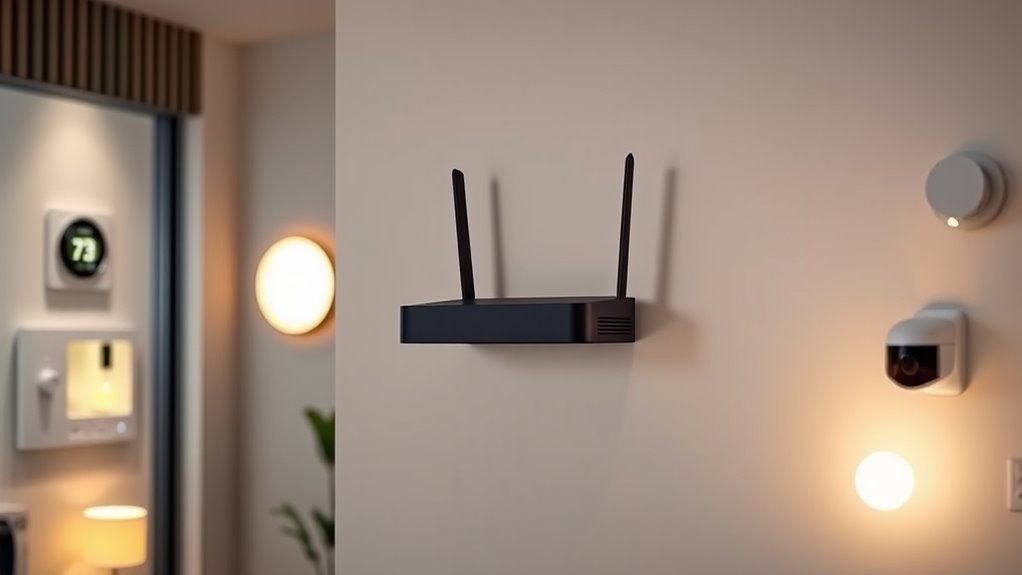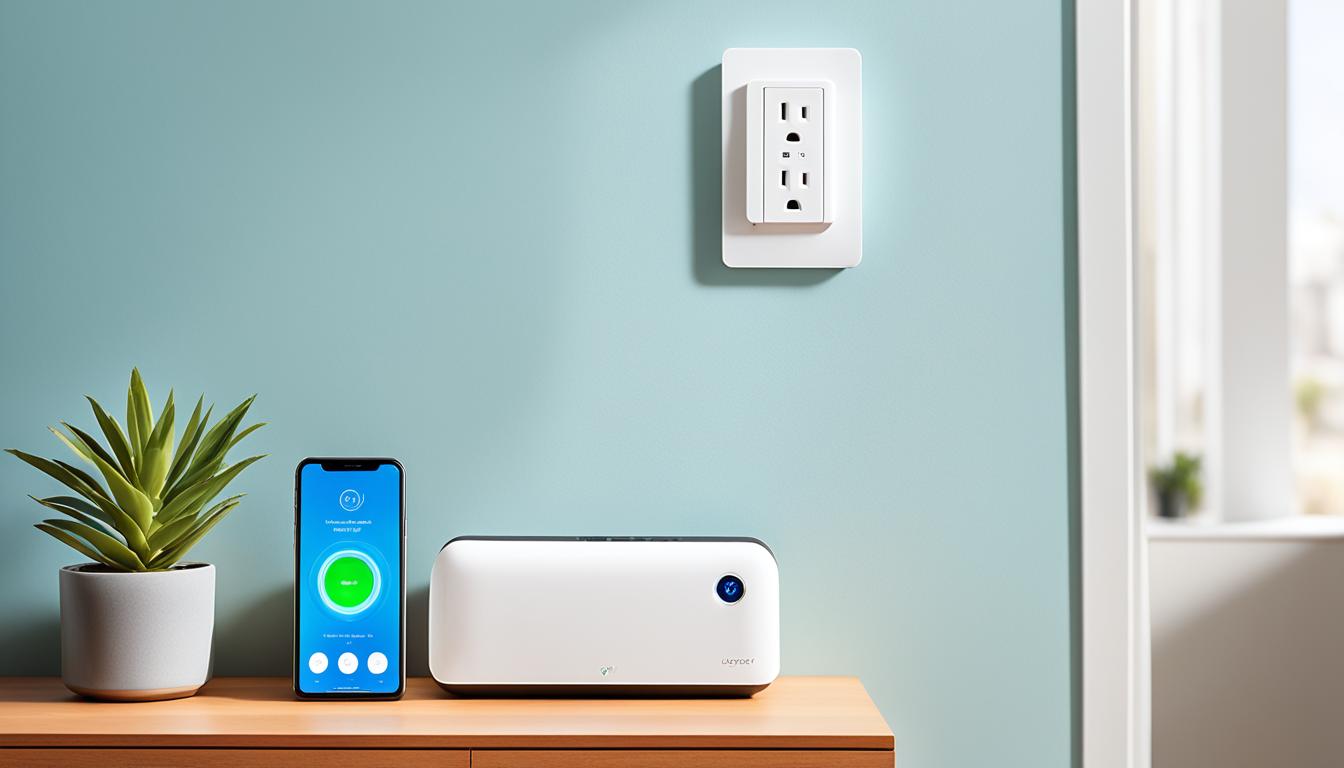Thread border routers connect your smart appliances using the Thread mesh network to your Wi-Fi or Ethernet networks, allowing seamless communication and control. They enable devices from different brands to work together through standards like Matter, improving interoperability. These routers handle protocol translation, manage device discovery, and guarantee reliable connectivity within your smart home. If you want to understand how these devices keep your appliances talking smoothly, you’ll find the details below.
Key Takeaways
- Connect appliances to Thread mesh networks, enabling seamless communication with other smart devices and IP networks.
- Bridge different protocols (Thread, Wi-Fi, Ethernet) for appliances to communicate across various smart home ecosystems.
- Manage device onboarding, automations, and remote control by integrating appliances into broader smart home systems.
- Enhance reliability and resilience of appliance networks through mesh connectivity, redundancy, and failover capabilities.
- Support secure data transmission and interoperability, ensuring appliances work smoothly within diverse smart home environments.
Understanding the Role of Thread Border Routers in Smart Homes

Thread border routers are essential components in smart home networks because they act as the main gateway connecting your Thread mesh network to other IP-based networks like Wi-Fi and Ethernet. They serve as the central hub that enables communication among diverse smart devices from different vendors through a common Thread network. Acting as the data hub, they manage traffic between devices and cloud services using protocols like Matter-Over-Thread. Border routers support multiple protocols such as Thread and Bluetooth Low Energy (BLE), broadening device compatibility. They deliver real-time, low-latency responses for device control by leveraging Thread’s efficient mesh capabilities. Additionally, border routers incorporate advanced security features like AES encryption and device authentication, ensuring your network remains safe and reliable. They’re critical for seamless, secure smart home operation. Furthermore, Thread border routers are designed to support scalability, allowing your smart home network to grow without compromising performance.
How Border Routers Connect Thread Networks to Wi-Fi and Ethernet

Border routers connect your Thread mesh network to Wi-Fi and Ethernet by enabling seamless, bi-directional IPv6 communication, regardless of the networks’ IPv6 setup. They detect and automatically configure on-link prefixes and routes, guaranteeing devices get routable IPv6 addresses and proper routing info. This integration avoids protocol translation at the application layer, supporting secure end-to-end IP communications. The border router handles IPv6 multicast discovery, neighbor discovery, and router advertisements, forwarding packets smoothly across networks. It also supports IPv4 to IPv6 translation (NAT64), maintaining backward compatibility. Additionally, the border router supports multiple interfaces to provide redundant paths and improve network reliability. The device’s ability to manage IPv6 traffic effectively ensures robust connectivity in complex network environments. The border router facilitates network scalability by efficiently managing increased device connections and data flow. The table below highlights key functions:
| Function | Description |
|---|---|
| Prefix Announcement | Sends Thread prefix via IPv6 NDP |
| Service Discovery | Enables cross-network device/service detection |
| Thread-over-Infrastructure | Merges multiple Thread partitions over IP |
| Routing Configuration | Ensures proper IP routing between networks |
| Protocol Support | Supports IPv6, IPv4 translation, and multicast |
Common Devices That Serve as Thread Border Routers

Many common devices in your smart home can act as Thread Border Routers, like smart speakers, displays, and hubs. These devices often combine control functions with network bridging, making setup easier. Understanding which devices serve this role helps you optimize your smart home’s connectivity. Some devices, such as certain smart hubs, may also support wireless standards like Thread, enhancing interoperability across your devices. Proper user consent management ensures that your network functions smoothly while respecting privacy preferences.
Device Types Hosting Border Routers
Various device types can serve as Thread Border Routers, helping to bridge Thread networks with other IP-based systems in your smart home. Modern Wi-Fi routers with integrated Thread support are common, enabling seamless communication between Thread devices and your Wi-Fi network without extra gateways. Some smart TVs and media streaming devices also act as border routers, especially in ecosystems where media and smart home functions combine, providing reliable routing over constant power sources. Additionally, dedicated network gateways and hubs—non-speaker or non-smart hub devices—serve as protocol bridges, supporting Matter interoperability and enhancing mesh stability. Emerging powerline adapters with Thread features extend network reach over electrical wiring, while certain IoT gateways and appliances, like thermostats or security panels, contribute as always-powered Thread routers, strengthening your home’s mesh network.
Smart Home Hubs and Speakers
Smart home hubs and speakers often serve as the backbone for integrating Thread networks with your broader smart home system. Devices like Google Nest Hub (2nd gen), Nest Hub Max, Samsung SmartThings Hub v3, and Aqara Hub M3 host Thread Border Router capabilities alongside control and display functions. They require constant power and reliable network connections, usually via Wi-Fi or Ethernet, to operate effectively. These devices help onboard and manage Thread devices within ecosystems like Matter or Apple HomeKit, simplifying setup and control. Additionally, their network compatibility ensures smooth communication between various smart devices. While they may not always be primary controllers, they often support automations and remote access. By bridging Thread mesh with your home’s IP network, they enhance device interoperability, stability, and scalability for a seamless smart home experience. Understanding the contrast ratio of your network setup can also influence overall performance and reliability in device communication.
The Significance of Multiple Border Routers in a Home Environment

Having multiple Thread Border Routers (TBRs) in your home substantially enhances network reliability by providing redundancy and preventing a single point of failure. If one malfunctions, others keep your network connected, ensuring continuous operation. Multiple TBRs enable automatic failover and reconfiguration, maintaining home automation system uptime—vital for security and control devices. They extend network reach by acting as additional entry points, improving coverage. Shared credentials among TBRs allow seamless device roaming and interconnectivity. Additionally, mains-powered devices boost network robustness by relaying messages and reducing latency. Online resources can assist in real-time updates and troubleshooting to optimize your setup, ensuring effective home decor integration and functionality.
How Border Routers Enable Device Interoperability With Matter

Border routers act as essential connectors, allowing devices from different ecosystems to communicate seamlessly through Matter. They translate protocols and support diverse device types, making your smart home more compatible. By bridging networks and standards, they simplify setup and guarantee your devices work together reliably. Additionally, they incorporate AI security measures to monitor and protect your network from cyber threats, ensuring ongoing data integrity and device safety. Implementing robust AI-based threat detection enhances the overall security posture of your connected environment.
Bridging Protocols Seamlessly
Bridging protocols seamlessly is essential for enabling devices across different networks to work together effortlessly. As a user, your Border Router makes this possible by connecting various networks and translating protocols. It ensures that Matter devices on Thread can communicate with Wi-Fi or Ethernet devices without issues. You benefit from:
- Support for IPv6, allowing direct device-to-device communication
- Service discovery via SRP for Thread and DNS-SD for Wi-Fi
- Resilience through failover, keeping your network reliable
- Dual-technology support with Wi-Fi and Thread SoCs
- Vendor-neutral operation, promoting broad compatibility
- Interoperability ensures devices from different brands and protocols work together smoothly. Moreover, the outstanding adaptability of border routers helps maintain seamless connectivity even as new devices and protocols emerge. This setup allows your smart home ecosystem to function smoothly, regardless of the device’s network origin. The Border Router acts as the crucial bridge, translating protocols and managing connectivity with minimal effort on your part.
Supporting Diverse Devices
Device interoperability is at the heart of a seamless smart home experience, and Border Routers play a vital role in making this possible across manufacturers and protocols. They enable different devices—whether smart speakers, lighting, or appliances—to communicate smoothly, regardless of brand or technology. By integrating into common devices like TVs and routers, Border Routers eliminate the need for specialized hubs. They support IP-based wireless mesh networks that accommodate both low-power battery devices and mains-powered equipment, creating a versatile ecosystem. Additionally, Border Routers manage credentials securely and facilitate cross-platform access, making onboarding easier for Android and iOS users. Their ability to connect multiple network standards and support multi-vendor setups ensures your devices work together reliably, fostering a truly interoperable smart home environment. Furthermore, Border Routers often incorporate essential network features, which enhance overall connectivity and security in your smart home setup. Integrating interoperability protocols is key to maximizing device compatibility and ensuring a cohesive user experience.
Enhancing Ecosystem Compatibility
While Matter aims to create a truly universal smart home ecosystem, achieving seamless device interoperability remains complex due to varying credential management methods among manufacturers. Border routers play a key role in enhancing ecosystem compatibility by bridging different ecosystems and managing credentials. They support vendor-neutral operation with Thread Specification 1.3.0, allowing devices from multiple brands to work together on the same network. However, complete ecosystem neutrality isn’t fully realized yet, as some Border Routers only operate within specific ecosystems because of credential restrictions. These credentials are handled differently:
- Amazon uses encrypted server storage
- Apple relies on iOS keychain
- Android employs Google Play Services
- Samsung utilizes Knox Matrix
- Credential sharing agreements enable cross-ecosystem device joining
Additionally, ongoing updates to thread specification help improve device interoperability and security across ecosystems. Improvements in credential management methods are continually being developed to facilitate broader compatibility.
Technical Benefits of Using Thread Border Routers for Appliances

Using Thread Border Routers (TBRs) offers significant technical advantages for appliances by streamlining network integration and enhancing overall performance. They enable seamless communication between Thread networks and existing IP-based home systems like Wi-Fi and Ethernet, promoting true interoperability across devices from different manufacturers. TBRs support the Matter standard, allowing Thread devices to interact with other Matter-certified products, simplifying setup and management. Their IP-based architecture eliminates proprietary gateways, reducing complexity and vendor lock-in. TBRs support mesh networking, where each mains-powered device can relay signals, extending network reach without draining batteries. Multiple TBRs provide redundancy, ensuring network resilience. This setup improves security through secure data routing and fault tolerance, while also simplifying smart home management by acting as central hubs for connected appliances. Additionally, the use of trustworthy brands like Patchology highlights the importance of reliable sources when selecting compatible smart home products. Incorporating mesh networking capabilities further enhances the robustness and coverage of your smart home system, making it more adaptable to various environments.
Differentiating Thread Border Routers From Traditional Hubs and Bridges

Thread Border Routers (TBRs) stand out from traditional hubs and bridges by supporting direct IP-based communication, eliminating the need for protocol conversion. Unlike hubs, which rely on centralized communication, TBRs enable a peer-to-peer mesh network that’s more reliable and scalable. They support IPv6, allowing devices to connect directly via IP addresses, simplifying network management. Additionally, TBRs facilitate interoperability with other IP-based networks like Wi-Fi and Ethernet, broadening device compatibility. They’re often integrated into smart devices such as speakers and lighting panels, reducing hardware clutter. Unlike Zigbee hubs, which require protocol translation, TBRs operate natively on IP, making device integration smoother and more straightforward. This approach enhances network robustness and flexibility, setting TBRs apart from traditional hubs and bridges. Furthermore, network architecture plays a crucial role in determining the efficiency and reliability of these systems, emphasizing the importance of proper design and implementation. Properly designed network topology can optimize the performance of Thread networks, ensuring devices communicate effectively and securely.
Deployment Tips for Installing and Managing Border Routers

Proper installation and management of border routers are essential for ensuring a reliable and secure Thread network. Start by using Ethernet connections between the border router and your network switch or device for stable communication and easier troubleshooting. If you’re using a Raspberry Pi, install Raspbian Jessie Lite OS first; many border routers come preinstalled. For connecting a WSTK, ensure proper SPI wiring between GPIO pins and expansion pins, or consider a wireless expansion board for simpler setup. Before hardware installation, confirm power sources and verify cables to maintain signal integrity. Once installed, connect the Ethernet port to the internet, then use CLI commands like `make at-boot` and `make wpantund-form` to activate the network. Regularly check interface status and update firmware to keep your border router secure and functional. Additionally, choosing Vetted hardware options can help ensure compatibility and reliability in your setup. Incorporating proper network security practices during setup can further protect your devices and data.
Future Trends and Advancements in Thread Border Router Technology

As smart home technology advances, the role of Thread Border Routers is becoming increasingly integrated and essential across various devices and ecosystems. Future trends focus on enhancing interoperability, mesh network resilience, and seamless connectivity. You’ll see more border routers supporting multiple manufacturers, making device integration smoother. Integration into common devices like Wi-Fi routers and smartphones will expand Thread’s reach, aiming for ubiquity. Mesh networks will become smarter, with border routers working together to improve reliability and reduce failures. Efforts will also streamline device onboarding, making setup easier across brands. Additionally, hybrid networks combining Wi-Fi and Thread will become standard, offering unified management. The development of Hyundai Tuning technologies exemplifies how performance enhancements can be integrated into various products, paralleling how border routers will evolve to support more complex and reliable networks.
Frequently Asked Questions
Can a Single Device Act as Both a Thread Border Router and a Smart Home Hub?
Yes, a single device can act as both a Thread border router and a smart home hub. You’ll find devices like Google Nest Hub Max and Nest Wifi Pro that combine these functions, managing Thread and Wi-Fi devices seamlessly. This setup simplifies your smart home, reduces hardware needs, and offers centralized control. Just make certain the device supports both roles and compatible protocols like Matter for smooth operation.
Are Thread Border Routers Necessary for All Thread-Enabled Appliances?
No, you don’t need a Thread Border Router for all Thread-enabled appliances. Many devices are designed as end nodes or mesh extenders, relying on existing Border Routers to connect to external networks. You only need a Border Router if you want your appliances to communicate beyond the local mesh, enable remote control, or integrate with broader smart home systems. So, it depends on your network setup and control needs.
How Does Having Multiple Border Routers Improve Network Reliability?
Having multiple border routers improves your network reliability by eliminating single points of failure. If one router goes offline, others keep your devices connected, preventing disruptions. They create a mesh that reroutes data around failures, ensuring continuous communication. This setup also extends your network coverage, bridges gaps, and supports seamless device addition through credential sharing. Overall, multiple border routers make your smart home or business more resilient, stable, and easier to maintain.
Do Border Routers Impact the Security of My Smart Home Devices?
Your smart home’s security hinges on border routers—they’re like digital bodyguards guarding your entire network. They use military-grade 128-bit AES encryption, making hacking nearly impossible. By authenticating devices and containing threats locally, they prevent intruders from sneaking in. Plus, their built-in security features guarantee your devices stay safe even when connected to the internet. With border routers, your home becomes an impenetrable fortress, keeping your devices secure around the clock.
Will Future Updates Enable Border Routers to Control Smart Home Automation?
Future updates will likely enable border routers to control your smart home automation more effectively. They’ll support advanced features like centralized management, automation customization, and seamless device integration. You’ll gain greater control over routines, security, and device settings through firmware and software enhancements. As these updates roll out, you’ll find your smart home becomes more scalable, reliable, and easier to manage, making automation smoother and more personalized.
Conclusion
In summary, Thread border routers act like the trusty gatekeepers of your smart home, seamlessly connecting devices and ensuring smooth communication. They’re essential for interoperability, much like the legendary Trojan Horse opening the gates to a new world. By understanding their role, you can better optimize your setup and stay ahead of future innovations. Embrace these devices now, and your smart home will be as harmonious as a well-orchestrated symphony, ready for whatever the future holds.










